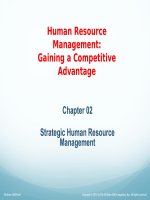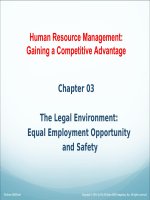Human resource management gaining a competitive advantage 2014 chapter 11
Bạn đang xem bản rút gọn của tài liệu. Xem và tải ngay bản đầy đủ của tài liệu tại đây (1.01 MB, 25 trang )
Human Resource Management:
Gaining a Competitive Advantage
Chapter 11
Pay Structure Decisions
McGraw-Hill/Irwin
Copyright © 2013 by The McGraw-Hill Companies, Inc. All rights reserved.
Developing Pay Levels
Pay structure - relative pay of different jobs (job
structure) & how much they are paid (pay level).
Pay level - average pay, including wages, salaries &
bonuses.
Job structure - relative pay of jobs (range of pay often
expressed by salary grades).
Pay policies are attached to jobs, not individuals.
11-2
Equity Theory & Fairness
Pay Structure Concepts & Consequences
11-3
Developing Pay Levels-Market Pressures
2 Competitive Market Challenges in Pay Decisions:
1. Product-market competition-challenge to sell goods
and services at a quantity and price that will bring a
return on investment.
2. Labor-market competition-amount an organization
must pay to compete against other organizations that
hire similar employees.
Unless higher labor costs are offset by higher worker productivity or
desirable product features that allow a higher product price, it will
be difficult to sustain relatively high costs in a competitive product
market.
11-4
2 Components of Labor Costs
11-5
Employees as a Resource
A philosophy that considers employees to be
an investment that will yield valuable returns.
Controlling costs through noncompetitive pay
can result in low employee productivity and
quality.
Pay policies and programs are important HR
tools for encouraging desired employee
behaviors and discouraging undesired
behaviors.
11-6
Deciding What to Pay
Deciding pay levels is discretionary and is based
on a broad range.
The organization has to decide whether to pay at,
below, or above the market average.
Efficiency wage theory- wages influence worker
productivity.
11-7
Market Pay Surveys
Benchmarking- procedure by which an
organization compares its own practices against
the competition.
3 issues to consider before using pay surveys:
1. Which employers should be included in the survey?
2. Which jobs are included in the survey?
3. If multiple surveys are used, how are all rates of pay
weighted and combined?
11-8
Product Market VS. Labor Market Comparisons
11-9
Rate Ranges, Key & Non-key Jobs
Rate ranges- different employees in same job
that may have different pay rates.
Key jobs- benchmark jobs that have relatively
stable content and are common to many
organizations so that market-pay survey data
can be obtained.
Non-key jobs are unique to organizations and
cannot be directly valued or compared
through the use of market surveys.
11-10
Developing a Job Structure
Job structure- relative worth of various jobs in
based on internal comparisons.
Job evaluation- administrative procedure used
to measure internal job worth.
The evaluation process is composed of
compensable factors, which are characteristics of
jobs that an organization values and chooses to pay.
Job evaluators often apply a weighting scheme to
account for differing importance of compensable
factors to the organization.
11-11
Developing a Pay Structure
3 Pay-setting Approaches:
1. Market Survey Approach - greatest emphasis is
on external comparisons. It bases pay on market
surveys that cover as many key jobs as possible.
2. Pay Policy Line – mathematical expression that
describes the relationship between a job’s pay and
its job evaluation points.
3. Pay Grades- Grouping jobs of similar worth or
content together for pay administration purposes.
Range spread -distance between minimum & maximum
amounts in a pay grade.
11-12
Conflicts – Market Pay Surveys & Job Evaluation
Internal data drives up labor costs and create productmarket problems.
If external market data are emphasized and a job is paid
lower internally, comparisons that employees make
internally would result in dissatisfaction.
An organization should consider its strategy, what jobs
and/or functions will be critical for success and marketcompetitive pressures.
11-13
Monitoring Compensation Costs
To examine the difference between policy and
practice, compute a compa-ratio, which is an index
of the correspondence between actual and intended
pay.
11-14
Globalization, Geographic Region & Pay Structure
Pay structures differ across countries in level &
relative worth of jobs.
Expatriate pay and benefits depend on
assignment’s nature and length.
11-15
Current Challenges
Job-based pay structures can create problems:
reinforces top-down decision making as well as status
differentials.
bureaucracy, time and cost required to generate and
update job descriptions can become a barrier to
change.
job-based structure may not reward desired behaviors,
where the knowledge, skills, and abilities needed
yesterday may not be helpful today and tomorrow.
system encourages promotion-seeking behavior, but
discourages lateral movement.
11-16
Responses Job-Based Pay Structures
11-17
Can the U.S. Labor Force Compete?
U.S. labor cost are high compared to newly industrialized
and developing countries.
4 Factors Shifting Production to Other Countries:
11-18
Executive Pay
Executive pay has been given widespread
attention in the press.
Executive pay accounts for a small proportion of
labor costs.
Executives have a disproportionate ability to
influence organizational performance.
Executives help set culture, so if their pay seems
unrelated to organizational performance, employees
may not understand why their pay should be at risk
depending on the organization's performance.
11-19
CEO Remuneration in U.S. Dollars
11-20
Reasons for Executive Pay Criticisms
Some executives are very highly paid.
U.S. executives - best paid in the world.
Ratio of executive pay to average worker
pay creates a "trust gap" - workers do not
trust executives' intentions and resent their
pay.
11-21
EEO- Employment Compensation
among executives women appear to
have lower pay than men
women comprised 47% of all
employees in 2011
11-22
Equal Employment Opportunity
(EEO) regulations prohibits sex & race-based
differences in employment outcomes such as pay,
unless justified by business necessity.
2 Trends Related to EEO:
1. increasing participation of women and
2.
nonwhites in the labor force.
proportion of wages in 2010:
women compared to men was 81%.
black to white was 80%.
Hispanic-Latino to white earning was 70%.
11-23
Comparable Worth
Comparable worth (or pay equity) is a public
policy that advocates remedies for any
undervaluation of women's jobs.
Based on the idea that individuals should obtain
equal pay, not just for jobs of equal content, but for
jobs of equal value or worth.
Courts have consistently ruled that using the going
market rates of pay is acceptable defense in
comparable worth litigation suits.
11-24
Wage Laws
The Fair Labor Standards Act (FLSA) of 1938
established a minimum wage and overtime pay rate.
Minimum wage is $7.25 an hour. It is the lowest
amount that employers are legally allowed to pay.
Exempt –those employees (executive, professional,
administrative and outside sales) not covered by the
FLSA and not eligible for overtime pay.
Davis-Bacon Act and Walsh-Healy Public Contracts
Act require federal contractors to pay employees no
less than area’s prevailing wages.
11-25









